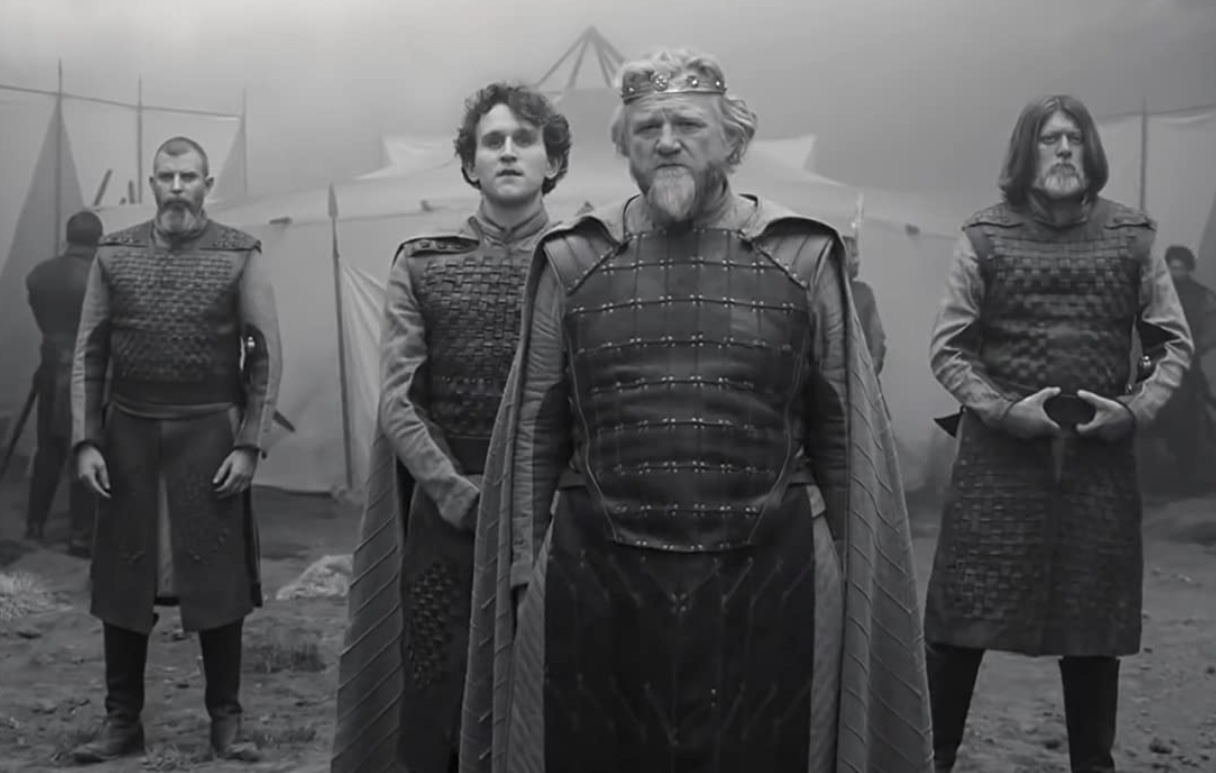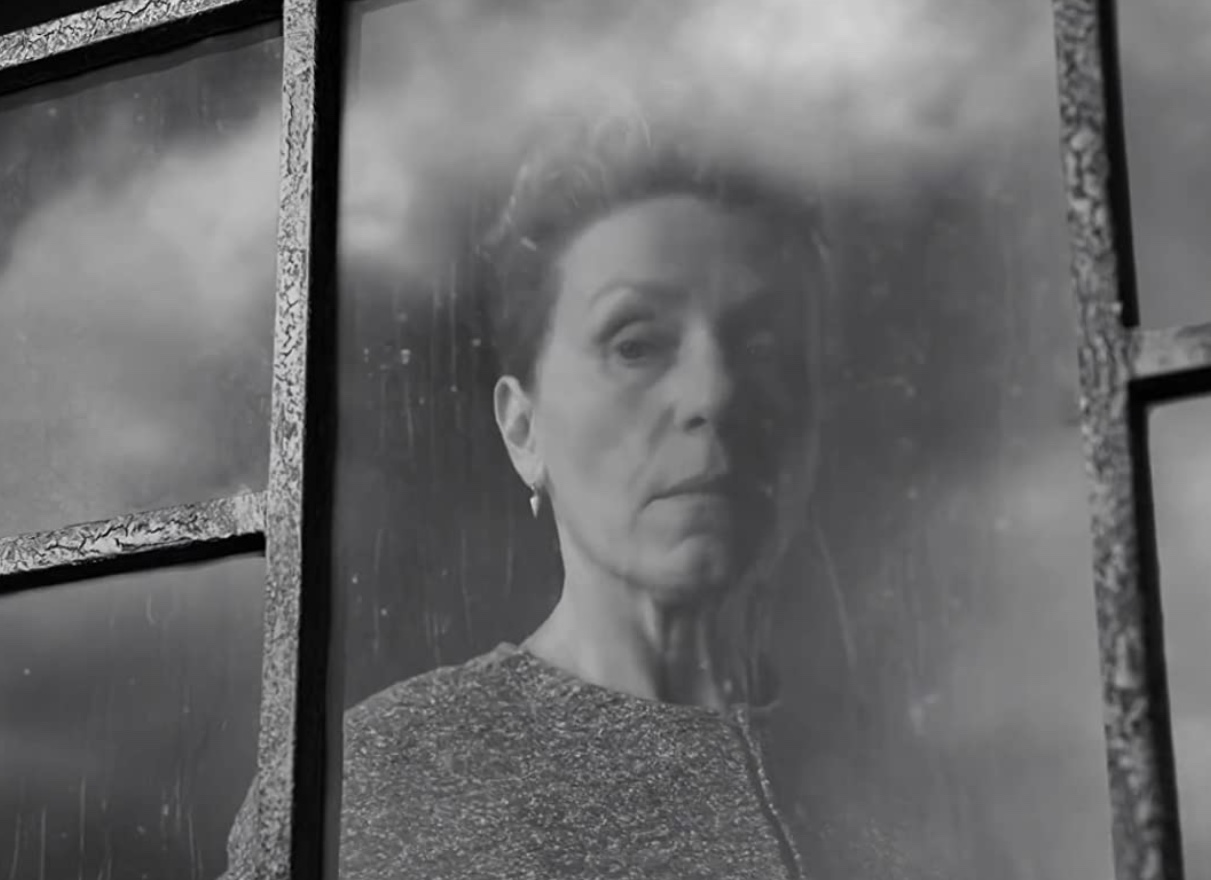
Denzel Washington and Frances McDormand in The Tragedy of Macbeth
“What’s done cannot be undone,” and with a film as well-made as director/scripter Joel Coen’s adaption of William Shakespeare’s “The Tragedy of MacBeth, why would you want it to be?
The oft-told tale of murder, madness, and revenge is available on Apple TV after a short theatrical release, and the film starring Denzel Washington and Frances McDormand as MacBeth and his Lady is a stunningly rich accomplishment for Coen, who directs alone without his usual partner, his brother Ethan.
Coen’s script does make some changes and/or minor alterations to the original story that might rankle some Shakespeare purists or aficionados, but if you hadn’t read the original play in awhile — 36 years for me — you might not catch any of them. Had I not been alerted to the divergences in a news article prior to the film being released, I would not have noticed.
The first of the most pertinent changes is the age of MacBeth and of his wife, who are in their 60s in the film but much younger in the play. The second is that the third party to the murder of King Duncan (Brendan Gleeson) is named. It was left a mystery or just unrevealed in the original play, and I will not tattle here.
Washington and McDormand, who is married to Coen, give hefty performances as the power-mad couple who commit murder in their own home to rise in station for a short while before their own hubris, guilt, and madness cut them low.

Brendan Gleeson and Harry Melling in The Tragedy of Macbeth
The film is shot in black and white with gorgeous cinematography by Bruno Delbonnel. The sets are sparse — much like a play — with the focus mostly trained on the the performances; however, Coen’s choices of shadow and light imbues each scene with an ambiance that just can’t be achieved in color.
The light and the dark serve as an almost subconscious cues on how we should feel about the character on the screen.
Washington is often shot in half-shadow prior to the murder of Duncan, but after the dark deed is done, the character no longer lingers in the dark as his madness swells. He’s out in the open and out of control.
McDormand plays Lady MacBeth’s descent into madness and regret powerfully well. She is her husband’s partner in every way through the assassination, but delves into despair and a certain loneliness as both she and her husband begin to suffer from fear, regret, and paranoia over their foul deeds that pushes them apart.
The performances throughout the movie are uniformly fine, but Kathryn Hunter who plays the three witches nearly steals the film even with a scant amount of screen time. The way she contorts and twists her body in her opening scene is otherworldly and doesn’t seem to be created by special effects.
Coen usually depicts only one witch at a time with the other two either taking the form of ravens or as reflections in a pool of water. Hunter, however, speaks each of the three witches lines.
Craftily Coen’s camera aids the actress in denoting the change in speaker with quick cuts to opposing angles. Simultaneously Hunter alters her voice as she shifts from witch to witch.
The quick cuts create a creepy effect, further underscoring Coen and Delbonnel’s mastery with the camera and the form.

Frances McDormand in The Tragedy of Macbeth
The violence in the film is quick and brutal. Duncan’s murder during near slumber is short and to the point. The climactic sword fight between MacBeth and MacDuff, played by Corey Hawkins, is elegantly fierce and lustily brutal.
In the fight, MacBeth holds the edge, but his hubris and mad desire for power puts him in jeopardy when he opts to reach to the ground for his fallen crown.
For a gasp, he takes his eyes off MacDuff, thus allowing a deadly opening for his opponent, who swiftly and expertly relieves MacBeth of his head.
It’s my favorite on-screen sword fight since “Rob Roy” from 1995 when a tortured Liam Neeson cleaved Tim Roth in two.
Coen’s pacing is tight and moving ever forward. Despite being built around soliloquies, the movie never loses momentum through its relatively swift one-hour and 45-minute running time.
I have to admit that I cheated a bit by watching the movie with closed captions turned on. Reading the dialogue along with hearing it helped me catch on to the film’s rhythm and cadence, while also bolstering my understanding of Coen’s take on Shakespeare’s verses.
I was a bit apprehensive about delving into the movie, but in Coen’s hands, the film is a well-told tale that was quite accessible and enjoyable. It’s a movie I likely will watch again.
(R) 1 hr. 45 min.
Grade: A
New in Local Theaters
• Redeeming Love (watch trailer) / (PG-13) 2 hr. 14 min. / AMC Fiesta Square, Malco Razorback, Malco Springdale, Malco Towne
• The King’s Daughter (watch trailer) / (PG) 1 hr. 37 min. / AMC Fiesta Square, Malco Razorback
• The Tiger Rising (watch trailer) / (PG) 1 hr. 42 min. / Malco Razorback, Malco Pinnacle
Classic Corner: TCM Friday Fright Fest on Jan. 28

If your blood is running a little cold in the chilly January wind, Turner Classic Movies has a five-film horror marathon on Friday Jan. 28 that should get your heart pumping hot. Yes, it’s a week away, but that gives you plenty of time to set your DVRs. Here’s a run down of the movies.
THEM!
The fright fest begins at 10:30 a.m. with the giant-ant creature feature “Them!” from 1954. James Whitmore and Edmund Gwenn — yes, the guy who played Kris Kringle in “Miracle on 34th Street” — help fight a mutated colony of giant ants.
The Mummy
Great Britain’s Hammer Films took the horror baton from Universal Studio in the late 1950s and basically remade many of the latter studio’s classic horror film’s in blood-curdling color and with more graphic violence and scantily clad — for the time — damsels in distress. Terrence Fisher directs and Peter Cushing and Christopher Lee (the Mummy) star in this remake of Universal’s 1933 classic. The film plays at 12:15 p.m.
The Curse of Frankenstein
While Hammer’s series of Dracula films proved to be more popular, “The Curse of Frankenstein” was its first descent into horror in 1957 and the first color movie to feature Dr. Frankenstein’s abominable creature. Directed by Terence Fisher and starring Peter Cushing as Dr. Frankenstein and Christopher Lee as his man-made monster, the movie doesn’t stick to the storyline of the novel any closer than Universal’s 1931 original adaptation, starring Boris Karloff. I personally prefer Universal’s horrors over Hammer’s in general, but there is certainly fun to be had with this movie featuring a Dr. Frankenstein, whose lust for young women rivals his desire to revive life from dead tissue. The movie plays at 2 p.m.
The Fly
With Hammer having hits with its versions of Frankenstein and Dracula, it didn’t take long for 20th Century Fox long to respond with a color horror/sci-fi picture featuring a new monster of its own with “The Fly” in 1958. When a fly enters into a scientist’s molecular transporter, its atoms are spliced and reconfigured along with the scientists to create two grotesque mutant creatures. The movie stars Vincent Price, Al Hedison, and Patricia Owens, and plays at 3:30 p.m.
House of Wax
Horror maven Vincent Price is back at 5:15 p.m. in the 1953 version of “House of Wax.” Price plays the owner of a wax museum, who populates his displays with human corpses of victims he tracked down and murdered. It’s hard for me to choose one favorite Vincent Price movie, but this one is certainly among the best.

